
A custom PFP helps you stand out, increases your visibility, and makes you instantly recognizable. This article explores why a personalized PFP is worth it for your brand and how it can level up your online presence.
Understanding Personal Branding in the Digital Era
Let’s start with personal branding—how you present yourself online, sharing who you are, what you stand for, and what you aim to achieve. Think of it as the blend of your personality, values, and goals. In today’s world, having a solid personal brand isn’t just for big names; it’s crucial for freelancers, entrepreneurs, influencers, and professionals who want to stand out. Recent stats show that people with a defined personal brand can boost their career opportunities, networking, and influence.

Visuals play a huge role in this. A well-thought-out profile picture can make an instant connection, building trust and giving your audience a feel for who you are. Your PFP isn’t just a picture; it’s part of your brand’s first impression that sticks with your audience and shapes how they see you.
What Is a Custom PFP, and Why Does It Matter?
A custom PFP (Profile Picture) is more than a random selfie—a photo or graphic designed specifically to represent you and your brand. Unlike a standard image, a custom profile picture aligns with your personality, style, and brand message. It’s your chance to show your audience exactly what you’re about at a glance rather than leaving it up to guesswork.
The perks? A customized profile sets you apart in a sea of profiles, making you instantly recognizable and memorable. It builds up brand recall, so people associate your face or logo with the value you bring. Studies have even shown that custom visuals increase engagement and build trust. Think about it: when your profile picture looks polished and intentional, people are likely to take you seriously and trust what you say. A consistent, professional PFP can make all the difference in how your brand is perceived.
How a Custom PFP Elevates Your Online Presence
first impressions are everything online, and a professional, eye-catching PFP can be the difference between a quick scroll-by and a meaningful connection. If you’re ready to create your own, check out this custom PFP tool from Adobe Express, which can help you design a polished, brand-aligned profile picture that stands out. A well-designed PFP signals professionalism and attention to detail, setting a positive tone from the start.
A customized profile also boosts trust and credibility. Platforms like LinkedIn, Twitter, and Instagram thrive on authenticity, and a polished PFP shows you take your brand seriously. It helps people feel confident in following or connecting with you, which is crucial for building a professional network or audience.
Then there’s engagement. Case studies have shown that individuals who update their PFPs with a custom, cohesive design often see noticeable increases in likes, comments, and followers. Audiences respond to well-thought-out visuals that represent a clear brand, making them more likely to engage and stick around. In short, a customized profile picture isn’t just about aesthetics; it’s a powerful tool for attracting and retaining a loyal audience.
Steps to Designing an Effective Custom PFP
Designing a customized profile picture starts with understanding your brand’s personality. Think about what you want to convey—is your vibe professional, creative, approachable, or full of energy? Aim for clean lines and a neutral color scheme if you’re going for a professional look. Consider bolder colors or a more playful pose if creativity’s your thing.

Next, decide whether to work with a professional designer or try a DIY approach. A designer can craft a unique, high-quality image that perfectly aligns with your brand but might be a bit pricier. On the other hand, DIY tools are great if you’re on a budget and want to explore options yourself. There are plenty of easy-to-use apps and websites for creating a PFP, though you may not get the same custom look as with a designer.
Now, let’s talk about the elements of a successful PFP:
Color Scheme: Pick colors that reflect your brand’s personality. Blues often convey trust, while reds bring energy. Choose shades that feel right for you.
Facial Expression and Pose: Look approachable and confident—smiles or relaxed expressions usually work best.
Background: A simple, branded background keeps the focus on you and avoids visual clutter. It’s best to keep distractions to a minimum so the viewer’s attention stays on your face or logo.
With these steps, you’ll have a customized profile picture that truly represents you!
Best Practices for Using a Custom PFP Across Platforms
Consistency is key! Using the same PFP across all your social and professional profiles builds instant brand recall and trust. Whether people see you on LinkedIn, Instagram, or Twitter, they’ll recognize you right away if you’re consistent. It’s like having a familiar face wherever they go.
Consider specific adjustments to optimize your PFP for each platform. LinkedIn and Twitter work best with a clear, professional headshot, while Instagram and Facebook allow a bit more personality. Make sure your PFP is cropped well for each platform’s size requirements, so it always looks clear and sharp.
Quality is everything. A high-resolution image ensures your PFP doesn’t look blurry or pixelated, which can make your profile appear unprofessional. Use a high-quality original file and save it in a way that maintains resolution across different devices and platforms—your audience will appreciate the polished look.
Potential Pitfalls and How to Avoid Them
Avoid overly complex designs in your PFP. Too many details can make them hard to recognize in smaller sizes. Simplicity goes a long way toward creating a memorable image.
Also, try not to change your PFP too often. Frequent updates can confuse your followers, making it harder for them to recognize and remember you. Stick with a consistent image for a strong, lasting impression.
Lastly, always consider your audience’s preferences. If your target audience expects a more professional look, keep it polished. Your PFP should resonate with those you want to connect with, reinforcing the brand image you want to project.
Practical Tips for Maximizing Your Custom PFP’s Effectiveness
Your PFP can do more than look good—it’s a conversation starter. Choose an image that feels authentic and approachable, helping you connect with your audience personally. When should you update it? Only when there’s a significant shift, like a new role or brand direction, can you keep it consistent and recognizable?
Take it a step further by using your PFP in email signatures, business cards, and presentations. This way, your brand stays visually consistent, and people become familiar with “seeing” you across different spaces. It’s all about creating a cohesive brand experience.
Conclusion
A customized profile picture is a powerful asset in today’s digital world. It boosts your visibility, builds trust, and helps people recognize you instantly across platforms. By keeping it consistent, polished, and strategically placed, your PFP becomes a memorable part of your brand.
If you’re serious about leveling up your online presence, investing in a customized profile picture is a small step with a big impact. Start by designing an image representing your brand and carrying it across your profiles and materials. Little by little, you’ll build a cohesive, credible brand that makes you unforgettable.
